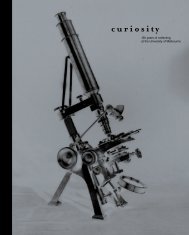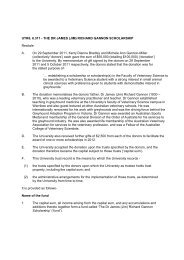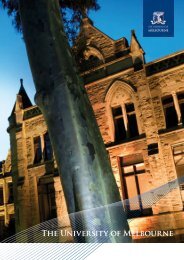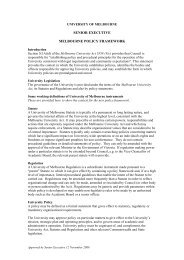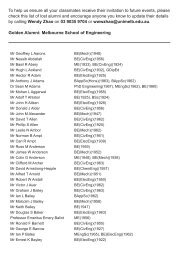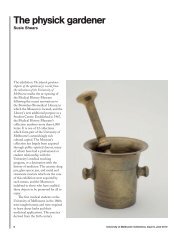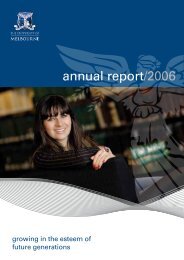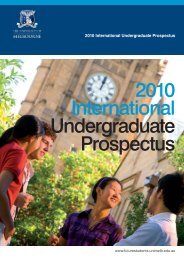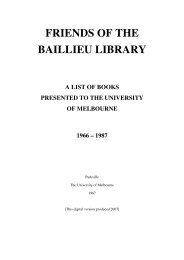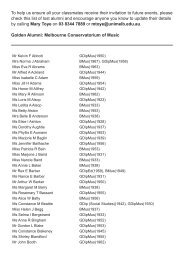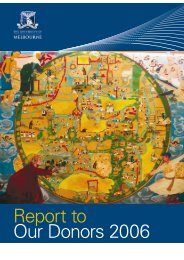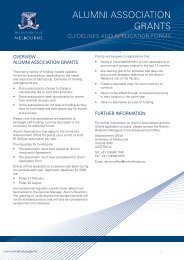Review of Australian Higher Education The Bradley Review
Review of Australian Higher Education The Bradley Review
Review of Australian Higher Education The Bradley Review
Create successful ePaper yourself
Turn your PDF publications into a flip-book with our unique Google optimized e-Paper software.
and announced cuts to the program, make it <strong>of</strong><br />
uncertain future financial significance. With these<br />
qualifications, we estimate that at the University <strong>of</strong><br />
Melbourne income per Commonwealth-supported<br />
student is approximately $2,000 less than average<br />
per student spending across the University.<br />
Though it does not examine the adequacy <strong>of</strong><br />
base funding, the only multi-university study <strong>of</strong><br />
spending by discipline was carried out by Access<br />
Economics and published in 2007. 5 It looked<br />
at the ‘relative funding model’ (RFM) that is<br />
the basis <strong>of</strong> the current funding system, under<br />
which disciplines are funded on a multiple <strong>of</strong> a<br />
base amount. In the six universities examined,<br />
covering 22 disciplines, it found that in half<br />
spending exceeded what the RFM allowed for,<br />
in six the RFM was approximately correct, and<br />
in the remaining five the RFM allowed for more<br />
funding than current spending. To the extent the<br />
RFM was ever accurate, it was by 2007 out <strong>of</strong><br />
alignment with spending realities. Some changes<br />
in the 2007–08 federal budget left most <strong>of</strong> these<br />
issues unresolved. 6<br />
4.1 <strong>The</strong> politics <strong>of</strong> funding<br />
<strong>The</strong> inevitable issue this funding history raises<br />
is whether the public can have confidence in<br />
the Commonwealth’s capacity to fund higher<br />
education in an appropriate manner. <strong>The</strong> problems<br />
have been chronic and bipartisan. <strong>The</strong>y are<br />
not just the result <strong>of</strong> particular governments or<br />
ministers not being sufficiently committed to<br />
higher education. Universities lack the political<br />
strength to push their case against other demands<br />
on government spending with much higher<br />
political salience. Schools, for example, have an<br />
electoral constituency many times the size <strong>of</strong> that<br />
available to higher education. <strong>The</strong>y have secured<br />
an indexation system which awards them real<br />
increases rather than real cuts. Health spending,<br />
which potentially affects almost every <strong>Australian</strong>,<br />
has increased at a very rapid rate. Figure 5 shows<br />
the funding trends since 1998.<br />
5 Access Economics, <strong>Higher</strong> <strong>Education</strong>: Cost Relativities and<br />
Pipeline, report to the Department <strong>of</strong> <strong>Education</strong>, Science and<br />
Training, March 2007.<br />
6 <strong>The</strong> 2007–08 Budget provided funding increases for the<br />
following disciplines that are under-funded according to<br />
the Access Economics report: mathematics and statistics,<br />
allied health, visual and performing arts, nursing, medicine,<br />
dentistry and veterinary science. It also provided funding<br />
increases for behavioural science, social studies, foreign<br />
languages, engineering, science and agriculture that did not<br />
need it, based on the Access Economics report. Averaged<br />
across the sector, the increases amount to about 3% per<br />
Commonwealth-supported student.<br />
Figure 5: Commonwealth spending on schools,<br />
universities and health<br />
$ million<br />
45,000<br />
40,000<br />
35,000<br />
30,000<br />
25,000<br />
20,000<br />
15,000<br />
10,000<br />
5,000<br />
0<br />
1998–99<br />
1999–2000<br />
2000–01<br />
2001–02<br />
Schools<br />
Universities<br />
Health<br />
2002–03<br />
2003–04<br />
2004–05<br />
2005–06<br />
2006–07<br />
Source: ABS, Government Finance Statistics, Cat. 5512.0<br />
Note: ABS university data does not include research funding.<br />
If there can be no confidence in adequate public<br />
funding <strong>of</strong> higher education, alternative private<br />
sources are needed as insurance against the<br />
forced cost-cutting that has occurred since 1989,<br />
such as increased student:staff ratios and the<br />
rundown <strong>of</strong> university facilities. While universities<br />
are actively seeking increased philanthropy, the<br />
only realistic option is to allow students to increase<br />
their co-investment in higher education. We know<br />
from past experience with HECS contributions,<br />
and from the booming full-fee market, that<br />
students are willing to make this investment in<br />
their education. Easing regulation on maximum<br />
fees would also protect would-be <strong>Australian</strong><br />
students from policies that encourage universities<br />
to enrol international students instead, even<br />
when—as occurred in the health pr<strong>of</strong>essions—an<br />
urgent need exists for more <strong>Australian</strong> graduates.<br />
4.2 Student co-investment<br />
In the past, HECS increases have required<br />
students to pay more for the same education.<br />
However, fewer restrictions on student<br />
co‐investment can benefit students by giving them<br />
more choices between types <strong>of</strong> institution and<br />
the option to vary the educational services they<br />
receive. While public funding can help engineer<br />
institutional diversity and improved student choice,<br />
it will emerge only slowly through institution-byinstitution<br />
compact negotiation on unique funding<br />
University <strong>of</strong> Melbourne <strong>Bradley</strong> <strong>Review</strong> Submission 13



